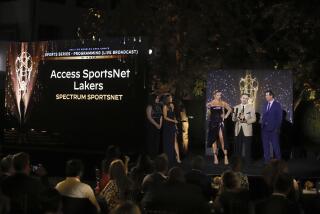Getting Customers Beyond the Cable Basics
- Share via
Having upgraded many of their systems with digital technology, cable operators could deliver a host of new information and entertainment services to their customers’ TV sets. So far, though, they’ve been reluctant to do more with their “broadband” pipes than add channels and pay-per-view movies.
That’s pretty mundane stuff compared with the gee-whiz applications on display at the cable industry’s semiannual trade shows. Why settle for four more versions of the Discovery Channel when the technology can deliver instant messaging, music downloads, arcade-quality games, movies on demand, multiple camera angles and videoconferencing?
Steve Silva, head of technology for Charter Communications, explained the thinking behind the go-slow approach during a recent visit to Pasadena. It boils down to this: Cable operators believe they have to teach consumers to walk with a remote control before they can run.
Charter, one of the half-dozen cable operators serving the Los Angeles area, is well into a $6-billion upgrade of its far-flung cable systems. The company has finished rebuilding the system that serves Pasadena, and Jerry Kent, Charter’s president and chief executive, said he plans to use the community as a test bed for new technology.
A few key pieces are still missing. For starters, the advanced set-top box needed for the most sophisticated services has been delayed for more than a year by software problems, although Silva said he expects to begin wide-scale roll-outs next year.
Beyond that, consumers aren’t necessarily ready for advanced services. As much as they might complain about TV, they’re extremely comfortable with it.
Each new digital service planned by the cable operators would change how and, in some cases, why people use their TV. In the process, the changes move viewers away from the simple channel-up, channel-down navigation of conventional TV to a more complex world with multiple commands and controls.
Silva sees the path to new services as a three-step process that starts with an interactive on-screen program guide, a feature that all cable operators are putting in their digital packages. Before operators can go any further, Silva said, consumers need to get comfortable using their remote controls to navigate through the on-screen guide, rather than just hitting the channel up or down buttons or using a printed set of listings.
As it happens, that’s not much of a stretch. Cable operators have found that the guide is the most popular feature.
The second step, Silva said, is for viewers to learn new ways to summon programming to their TVs.
One starting point for Charter is a simple interactive service from Alameda-based Wink Communications. When a Wink icon appears in a program or commercial, viewers can use their remote controls to take part in polls, contests and special offers that pop up on their TV screens.
Another starting point is video-on-demand service, which Charter recently introduced in Pasadena. Selecting from a library of several hundred titles, viewers can start, pause, rewind and fast-forward movies and other programs.
This summer, Charter plans to roll out a promising variation called subscription video-on-demand that lets viewers see any of a participating network’s programs whenever they wish, Silva said. Services could be built around a popular series (HBO, for example, is testing a “The Sopranos” on-demand package), a theme or special interest or a movie network’s monthly library, as the Starz Encore channels have proposed.
The final step, Silva said, is to move consumers from programs-on-demand to information-on-demand. That’s where the advanced set-top box comes in, bringing the Internet to TV sets through a high-speed modem.
Eventually, Charter wants to offer a wide range of Internet-related services to devices throughout the home, using wireless networking built into the advanced set-top boxes. “Broadband is really the ability to bring multiple applications to individuals in the home that can be simultaneously used,” Silva said.
That’s the goal. But first, “you’ve got to teach the consumer how to navigate on TV,” he said.
*
Times staff writer Jon Healey covers the convergence of entertainment and technology.
More to Read
The biggest entertainment stories
Get our big stories about Hollywood, film, television, music, arts, culture and more right in your inbox as soon as they publish.
You may occasionally receive promotional content from the Los Angeles Times.











